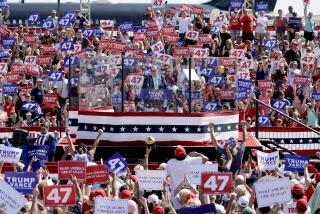Saddam Hussein’s Ultimate Fifth Column--Terrorists : Strategy: That old gang of bombers and assassins has attached themselves to the Iraqi leader and are ready to do his bidding in Europe and Mideast.
The crisis in the Middle East is like none the United States has ever faced. Saddam Hussein has rewritten the rules of modern warfare by taking thousands of Western hostages in his ruthless quest for Iraqi Lebensraum --and then by deploying them as human shields. Equally disquieting is the likelihood that the Iraqi leader has created the ultimate “fifth column”: an international terrorist army, arrayed throughout Europe and the Middle East, ready to strike at his command.
Ominiously, there are signs that he is preparing to unleash a campaign of international terrorism in hopes of breaking the international quarantine and military buildup that has isolated Iraq and is strangling its economy.
Since the spring, the most radical, hard-line Palestinian terrorist organizations have been moving their operational bases to Iraq. One after another, familiar faces have turned up in Baghdad: Abul Abbas, the mastermind behind the October, 1985, hijacking of the Italian cruise ship, Achille Lauro; Abu Nidal, the architect of the brutal machine-gun and hand-grenade attacks on the Rome and Vienna airports in December, 1985, and an Istanbul synagogue in September, 1986; and Ahmad Jabril, whose followers allegedly placed the bomb that brought down Pan Am flight 103 in December, 1988. According to one foreign intelligence estimate, there are now some 1,400 international terrorists in Iraq--twice the number of a year ago.
Last week, Abbas issued a proclamation ordering his men to attack U.S. interests around the world, in general, and American forces in Saudi Arabia, in particular. “Open fire on the American enemy everywhere,” he declared. “Quake the earth under the feet of the invaders and collaborators.”
Not to be outdone by a rival’s clarion call to battle, Nidal immediately followed suit, warning that his organization was preparing to carry out “90 attacks in 20 countries” against U.S. and Western targets.
The first evidence of the new alliance between Iraq and the radical Palestinians surfaced last May, when the Israeli navy thwarted an attack on Tel Aviv by members of Abbas’ organization traveling in speedboats. According to the surviving terrorists, Libya had provided training and logistical support. But it was Iraq that had planned and paid for the attack--whose targets included the beach-front U.S. embassy.
At the time, intelligence analysts were puzzled by Hussein’s motives in wooing the terrorists to Baghdad, ascribing his intentions, if at all, to his desire to supplant Libya’s Col. Moammar Kadafi as international terrorism’s chief benefactor. In retrospect, however, it appears that Hussein has been building an Iraqi-backed, brokered and controlled international terrorist infrastructure. With such an infrastructure already in place, he may well have created the ultimate “fifth column,” which, in a series of sharp, bloody, and destructive attacks, may have been the power to shatter the current standoff in the gulf by eroding both international and--perhaps, more importantly--the American public’s support for military action against Iraq.
Hussein certainly remembers that a terrorist campaign orchestrated by Iran in Beirut between 1983 and 1984 undermined American support for a U.S. military presence in Lebanon and thus led to the collapse of the multinational peace-keeping force sent to that country. This lesson must figure prominently in his strategy to deal with the U.S.-backed multinational force currently deployed in the Gulf.
International terrorism is perhaps the most cost-effective weapon in Iraq’s arsenal. Rather than having to expend his military might in direct combat with U.S. and allied forces in Saudi Arabia and the gulf, Hussein could covertly dispatch his terrorist minions to strike at considerably more vulnerable civilian, diplomatic or airline targets throughout Europe and the Middle East. His range of potential targets--and victims--would be restricted only by the reach and numerical strength of his terrorist infrastructure.
A carefully planned and well-executed Iraqi-backed terrorist campaign could also be a decisive weapon to destabilize--or even destroy--the governments of those Arab countries that oppose Iraq’s territorial designs. Hussein could thus accomplish with a few men and bombs what it took his army to do in Kuwait. At the very least, such a campaign could wear down the resolve of the pro-Western countries in the region to continue to support a U.S. military presence in Saudi Arabia and trade sanctions against Iraq.
A chain of terrorist attacks throughout Europe and the Middle East would certainly be grist for Hussein’s propaganda mill. In each case, the Iraqi president would deny any responsibility for or connection to the incident, even expressing surprise. But it is easy to imagine Iraqi officials smugly lauding such a “spontaneous outburst of anti-Western, anti-imperialist, anit-Zionist sentiment” against U.S. and Western interest by Iraq’s Arab brethren scattered around the world. In light of our past hesitancy to retaliate against state-sponsors of international terrorism without incontrovertible evidence directly linking them to an attack, this ruse could conceivably enable Iraq to escape retribution.
In the end, if Hussein remains in power and if Iraq retains its military might, other renegade regional powers will feel able to deploy thousands of civilian hostages as human shields and to deprive diplomats of their traditional protected status. Unconventional tactics--such as international terrorism--will then become institutionalized as instruments of modern warfare.
More to Read
Sign up for Essential California
The most important California stories and recommendations in your inbox every morning.
You may occasionally receive promotional content from the Los Angeles Times.










